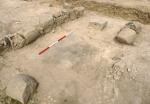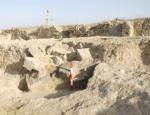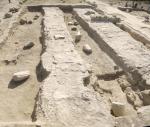Summary (English)
The 2012 season took place in September, directed by Elizabeth Fentress, Faouzi Ghozzi, Josephine Quinn and Andrew Wilson, followed by a 4-day geological coring season, jointly with Jean-Philippe Goiran’s geological team
Excavations in the monumental centre, Area II, continued. In 2010, excavations north of the road surface continued with the emptying of the robber trenches of the basilica. The working hypothesis is that the inner trench was dug for the removal the foundations and stylobate of an interior colonnade of Building 1, while the external one follows the line of the outer wall of the building. The complex clearly extended to the south, however, where another mortar preparation surface was discovered, measuring roughly 4 m north–south, separated from the road by a narrow robber trench approximately 1.50 m wide. It is thought that this structure might represent a portico running along the south side of Building 1, which is perhaps the civil basilica of Utica.
Medieval houses occupied both the edge of the basilica, building 1, and the area to the south of the road, where two medieval houses were discovered, buildings 3 and 4. All of these are relatively small structures, building 1 of a single room whose walls were based on column fragments.
In Area III, the House of the Grand Oecus, excavation continued of the high stratigraphy covering four rooms on the northern side of the site. The central room proves to be paved with a well-preserved opus sectile floor of giallo antico and black marble. The excavation of modern intrusions continued, notably of a large, bell-shaped pit filled with architectural fragments that appear to have come from the basilica.
A new Area, IV, was opened to the southwest of the town, where the geophysical survey revealed a trace which proved, on examination, to be a very large lime kiln. This is found in an area of buildings and traces of other kilns.
A final new Area, V, was dedicated to the examination of fish salting vats to the west of the monumental centre.
- Elizabeth Fentress
Director
- Andrew Wilson - University of Oxford
- Faouzi Ghozzi - Institut National du Patrimoine
- Josephine Quinn - Oxford University
Team
- Andrew Dufton - L - P : Archaeology
- Jean-Philippe Goiran- CNRS – Maison de l’Orient et de la Mediterranee
- Erica ROWAN
- Benjamin Russell
- Geoffrey Morley
- Nichole Sheldrick
- Skander Souissi
Research Body
- Institut National du Patrimoine
- University of Oxford - University of Oxford






![Download [PDF]](/excavation/skins/fasti/images/results/download_sml.png)


